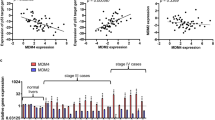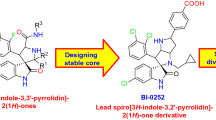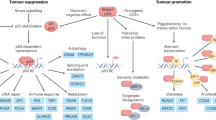Abstract
Restoration of p53 tumor suppressor function through inhibition of its interaction and/or enzymatic activity of its E3 ligase, MDM2, is a promising therapeutic approach to treat cancer. However, because the MDM2 targetome extends beyond p53, MDM2 inhibition may also cause unwanted activation of oncogenic pathways. Accordingly, we identified the microtubule-associated HPIP, a positive regulator of oncogenic AKT signaling, as a novel MDM2 substrate. MDM2-dependent HPIP degradation occurs in breast cancer cells on its phosphorylation by the estrogen-activated kinase TBK1. Importantly, decreasing Mdm2 gene dosage in mouse mammary epithelial cells potentiates estrogen-dependent AKT activation owing to HPIP stabilization. In addition, we identified HPIP as a novel p53 transcriptional target, and pharmacological inhibition of MDM2 causes p53-dependent increase in HPIP transcription and also prevents HPIP degradation by turning off TBK1 activity. Our data indicate that p53 reactivation through MDM2 inhibition may result in ectopic AKT oncogenic activity by maintaining HPIP protein levels.
Similar content being viewed by others
Log in or create a free account to read this content
Gain free access to this article, as well as selected content from this journal and more on nature.com
or
Abbreviations
- CAS:
-
Cellular apoptosis susceptibility
- EGF:
-
Epithelial growth factor
- ERα:
-
Estrogen receptor alpha
- GREB1:
-
Growth regulation by estrogen in breast cancer 1
- FOXO3a:
-
Forkhead box O3
- HPIP:
-
Microtubule-binding protein hematopoietic PBX-interaction protein
- HUWE1:
-
HECT, UBA and WWE domain-containing protein 1
- IKK:
-
I kappaB alpha kinase
- MDM2:
-
Mouse double minute 2
- MEC:
-
Mammary epithelial cell
- NAP1:
-
NAK (NF-kappaB-activating kinase)-associated protein 1
- NEMO:
-
NF-kappa B essential modulator
- PBX1:
-
Pre-B-cell leukemia homeobox protein 1
- PCR:
-
Polymerase chain reaction
- PI3K:
-
Phosphatidylinositide 3-kinase
- TANK:
-
TRAF family member associated NF-kappaB activator
- TBK1:
-
TANK-binding kinase 1
- TNFα:
-
Tumor necrosis factor alpha
References
Mandinova A, Lee SW . The p53 pathway as a target in cancer therapeutics: obstacles and promise. Sci Transl Med 2011; 3: 64rv61.
Vu BT, Vassilev L . Small-molecule inhibitors of the p53-MDM2 interaction. Curr Top Microbiol Immunol 2011; 348: 151–172.
Marine JC, Lozano G . Mdm2-mediated ubiquitylation: p53 and beyond. Cell Death Differ 2010; 17: 93–102.
Yang JY, Zong CS, Xia W, Yamaguchi H, Ding Q, Xie X et al. ERK promotes tumorigenesis by inhibiting FOXO3a via MDM2-mediated degradation. Nat Cell Biol 2008; 10: 138–148.
Kurokawa M, Kim J, Geradts J, Matsuura K, Liu L, Ran X et al. A Network of substrates of the E3 ubiquitin ligases MDM2 and HUWE1 control apoptosis independently of p53. Sci Signal 2013; 6: ra32.
Hers I, Vincent EE, Tavare JM . Akt signalling in health and disease. Cell Signal 2011; 23: 1515–1527.
Manning BD, Cantley LC . AKT/PKB signaling: navigating downstream. Cell 2007; 129: 1261–1274.
Yuan TL, Cantley LC . PI3K pathway alterations in cancer: variations on a theme. Oncogene 2008; 27: 5497–5510.
Altomare DA, Testa JR . Perturbations of the AKT signaling pathway in human cancer. Oncogene 2005; 24: 7455–7464.
Manavathi B, Acconcia F, Rayala SK, Kumar R . An inherent role of microtubule network in the action of nuclear receptor. Proc Natl Acad Sci USA 2006; 103: 15981–15986.
Abramovich C, Shen WF, Pineault N, Imren S, Montpetit B, Largman C et al. Functional cloning and characterization of a novel nonhomeodomain protein that inhibits the binding of PBX1-HOX complexes to DNA. J Biol Chem 2000; 275: 26172–26177.
Manavathi B, Lo D, Bugide S, Dey O, Imren S, Weiss MJ et al. Functional regulation of pre-B-cell leukemia homeobox interacting protein 1 (PBXIP1/HPIP) in erythroid differentiation. J Biol Chem 2012; 287: 5600–5614.
Andjelkovic M, Jakubowicz T, Cron P, Ming XF, Han JW, Hemmings BA . Activation and phosphorylation of a pleckstrin homology domain containing protein kinase (RAC-PK/PKB) promoted by serum and protein phosphatase inhibitors. Proc Natl Acad Sci USA 1996; 93: 5699–5704.
Gao T, Furnari F, Newton AC . PHLPP: a phosphatase that directly dephosphorylates Akt, promotes apoptosis, and suppresses tumor growth. Mol Cell 2005; 18: 13–24.
Trotman LC, Alimonti A, Scaglioni PP, Koutcher JA, Cordon-Cardo C, Pandolfi PP . Identification of a tumour suppressor network opposing nuclear Akt function. Nature 2006; 441: 523–527.
Ugi S, Imamura T, Maegawa H, Egawa K, Yoshizaki T, Shi K et al. Protein phosphatase 2A negatively regulates insulin's metabolic signaling pathway by inhibiting Akt (protein kinase B) activity in 3T3-L1 adipocytes. Mol Cell Biol 2004; 24: 8778–8789.
Song MS, Salmena L, Pandolfi PP . The functions and regulation of the PTEN tumour suppressor. Nat Rev Mol Cell Biol 2012; 13: 283–296.
Suizu F, Hiramuki Y, Okumura F, Matsuda M, Okumura AJ, Hirata N et al. The E3 ligase TTC3 facilitates ubiquitination and degradation of phosphorylated Akt. Dev Cell 2009; 17: 800–810.
Bae S, Kim SY, Jung JH, Yoon Y, Cha HJ, Lee H et al. Akt is negatively regulated by the MULAN E3 ligase. Cell Res 2012; 22: 873–885.
Barbie DA, Tamayo P, Boehm JS, Kim SY, Moody SE, Dunn IF et al. Systematic RNA interference reveals that oncogenic KRAS-driven cancers require TBK1. Nature 2009; 462: 108–112.
Korherr C, Gille H, Schafer R, Koenig-Hoffmann K, Dixelius J, Egland KA et al. Identification of proangiogenic genes and pathways by high-throughput functional genomics: TBK1 and the IRF3 pathway. Proc Natl Acad Sci USA 2006; 103: 4240–4245.
Shen RR, Hahn WC . Emerging roles for the non-canonical IKKs in cancer. Oncogene 2011; 30: 631–641.
Burris HA 3rd . Overcoming acquired resistance to anticancer therapy: focus on the PI3K/AKT/mTOR pathway. Cancer Chemother Pharmacol 2013; 71: 829–842.
Ou YH, Torres M, Ram R, Formstecher E, Roland C, Cheng T et al. TBK1 directly engages Akt/PKB survival signaling to support oncogenic transformation. Mol Cell 2011; 41: 458–470.
Xie X, Zhang D, Zhao B, Lu MK, You M, Condorelli G et al. IkappaB kinase epsilon and TANK-binding kinase 1 activate AKT by direct phosphorylation. Proc Natl Acad Sci USA 2011; 108: 6474–6479.
Guo JP, Coppola D, Cheng JQ . IKBKE protein activates Akt independent of phosphatidylinositol 3-kinase/PDK1/mTORC2 and the pleckstrin homology domain to sustain malignant transformation. J Biol Chem 2011; 286: 37389–37398.
Gatot JS, Gioia R, Chau TL, Patrascu F, Warnier M, Close P et al. Lipopolysaccharide-mediated interferon regulatory factor activation involves TBK1-IKKepsilon-dependent Lys(63)-linked polyubiquitination and phosphorylation of TANK/I-TRAF. J Biol Chem 2007; 282: 31131–31146.
Fujita F, Taniguchi Y, Kato T, Narita Y, Furuya A, Ogawa T et al. Identification of NAP1, a regulatory subunit of I kappa B kinase-related kinases that potentiates NF-kappa B signaling. Mol Cell Biol 2003; 23: 7780–7793.
Pomerantz JL, Baltimore D . NF-kappa B activation by a signaling complex containing TRAF2, TANK and TBK1, a novel IKK-related kinase. Embo J 1999; 18: 6694–6704.
Yamaoka S, Courtois G, Bessia C, Whiteside ST, Weil R, Agou F et al. Complementation cloning of NEMO, a component of the IkappaB kinase complex essential for NF-kappaB activation. Cell 1998; 93: 1231–1240.
Rae JM, Johnson MD, Scheys JO, Cordero KE, Larios JM, Lippman ME . GREB 1 is a critical regulator of hormone dependent breast cancer growth. Breast Cancer Res Treat 2005; 92: 141–149.
Campbell RA, Bhat-Nakshatri P, Patel NM, Constantinidou D, Ali S, Nakshatri H . Phosphatidylinositol 3-kinase/AKT-mediated activation of estrogen receptor alpha: a new model for anti-estrogen resistance. J Biol Chem 2001; 276: 9817–9824.
Keutgens A, Shostak K, Close P, Zhang X, Hennuy B, Aussems M et al. The Repressing Function of the Oncoprotein BCL-3 Requires CtBP, while Its Polyubiquitination and Degradation Involve the E3 Ligase TBLR1. Mol Cell Biol 2010; 30: 4006–4021.
Duong V, Boulle N, Daujat S, Chauvet J, Bonnet S, Neel H et al. Differential regulation of estrogen receptor alpha turnover and transactivation by Mdm2 and stress-inducing agents. Cancer Res 2007; 67: 5513–5521.
Vassilev LT, Vu BT, Graves B, Carvajal D, Podlaski F, Filipovic Z et al. In vivo activation of the p53 pathway by small-molecule antagonists of MDM2. Science 2004; 303: 844–848.
Patel S, Player MR . Small-molecule inhibitors of the p53-HDM2 interaction for the treatment of cancer. Expert Opin Invest Drugs 2008; 17: 1865–1882.
Mendrysa SM, McElwee MK, Michalowski J, O'Leary KA, Young KM, Perry ME . mdm2 Is critical for inhibition of p53 during lymphopoiesis and the response to ionizing irradiation. Mol Cell Biol 2003; 23: 462–472.
Callige M, Richard-Foy H . Ligand-induced estrogen receptor alpha degradation by the proteasome: new actors? Nucl Recept signal 2006; 4: e004.
Close P, Hawkes N, Cornez I, Creppe C, Lambert CA, Rogister B et al. Transcription impairment and cell migration defects in elongator-depleted cells: implication for familial dysautonomia. Mol cell 2006; 22: 521–531.
Viatour P, Dejardin E, Warnier M, Lair F, Claudio E, Bureau F et al. GSK3-mediated BCL-3 phosphorylation modulates its degradation and its oncogenicity. Mol cell 2004; 16: 35–45.
Chariot A, Leonardi A, Muller J, Bonif M, Brown K, Siebenlist U . Association of the adaptor TANK with the I kappa B kinase (IKK) regulator NEMO connects IKK complexes with IKK epsilon and TBK1 kinases. J Biol Chem 2002; 277: 37029–37036.
Leonardi A, Chariot A, Claudio E, Cunningham K, Siebenlist U . CIKS, a connection to Ikappa B kinase and stress-activated protein kinase. Proc Natl Acad Sci USA 2000; 97: 10494–10499.
Robert I, Aussems M, Keutgens A, Zhang X, Hennuy B, Viatour P et al. Matrix Metalloproteinase-9 gene induction by a truncated oncogenic NF-kappaB2 protein involves the recruitment of MLL1 and MLL2 H3K4 histone methyltransferase complexes. Oncogene 2009; 28: 1626–1638.
Keutgens A, Zhang X, Shostak K, Robert I, Olivier S, Vanderplasschen A et al. BCL-3 degradation involves its polyubiquitination through a FBW7-independent pathway and its binding to the proteasome subunit PSMB1. J Biol Chem 2010; 285: 25831–25840.
Acknowledgements
We are grateful to E Dejardin for helpful discussions and to the GIGA Imaging and Flow Cytometry Platform for performing the FACS and IF analyses. This work was supported by grants from the FNRS, TELEVIE, the Belgian Federation against cancer, the King Baudouin Fundation, the University of Liege (Concerted Research Action Program (BIO-ACET) and ‘Fonds Spéciaux’, the Inter-University Attraction Pole 6/12 (Federal Ministery of Science), the ‘Plan Cancer (Action 29)’, the ‘Centre Anti-Cancéreux’ and the ‘Leon Fredericq’ Fundation (ULg) as well as by the Walloon Excellence in Life Sciences and Biotechnology (WELBIO). PC, LN and AC are Research Associates and Senior Research Associate at the Belgian National Funds for Scientific Research (FNRS), respectively.
Author information
Authors and Affiliations
Corresponding author
Ethics declarations
Competing interests
The authors declare no conflict of interest.
Additional information
Edited by K Vousden
Supplementary Information accompanies this paper on Cell Death and Differentiation website
Supplementary information
Rights and permissions
About this article
Cite this article
Shostak, K., Patrascu, F., Göktuna, S. et al. MDM2 restrains estrogen-mediated AKT activation by promoting TBK1-dependent HPIP degradation. Cell Death Differ 21, 811–824 (2014). https://doi.org/10.1038/cdd.2014.2
Received:
Revised:
Accepted:
Published:
Issue date:
DOI: https://doi.org/10.1038/cdd.2014.2
Keywords
This article is cited by
-
The E3 ligase COP1 promotes ERα signaling and suppresses EMT in breast cancer
Oncogene (2022)
-
A novel chemical inhibitor suppresses breast cancer cell growth and metastasis through inhibiting HPIP oncoprotein
Cell Death Discovery (2021)
-
HPIP promotes epithelial-mesenchymal transition and cisplatin resistance in ovarian cancer cells through PI3K/AKT pathway activation
Cellular Oncology (2017)



